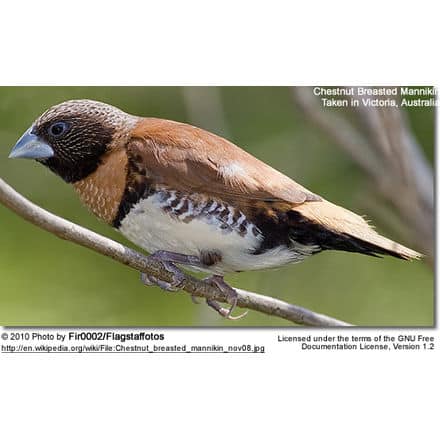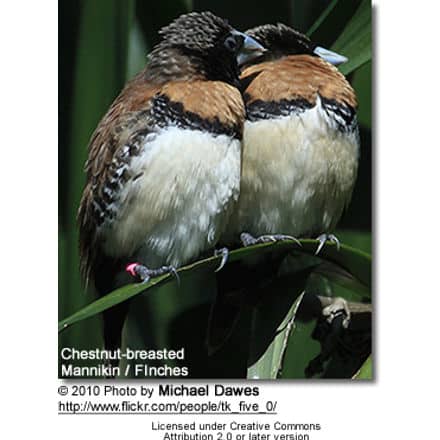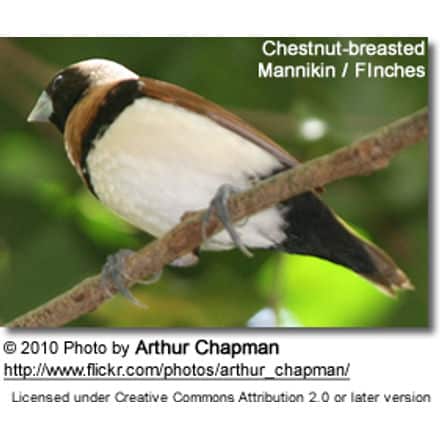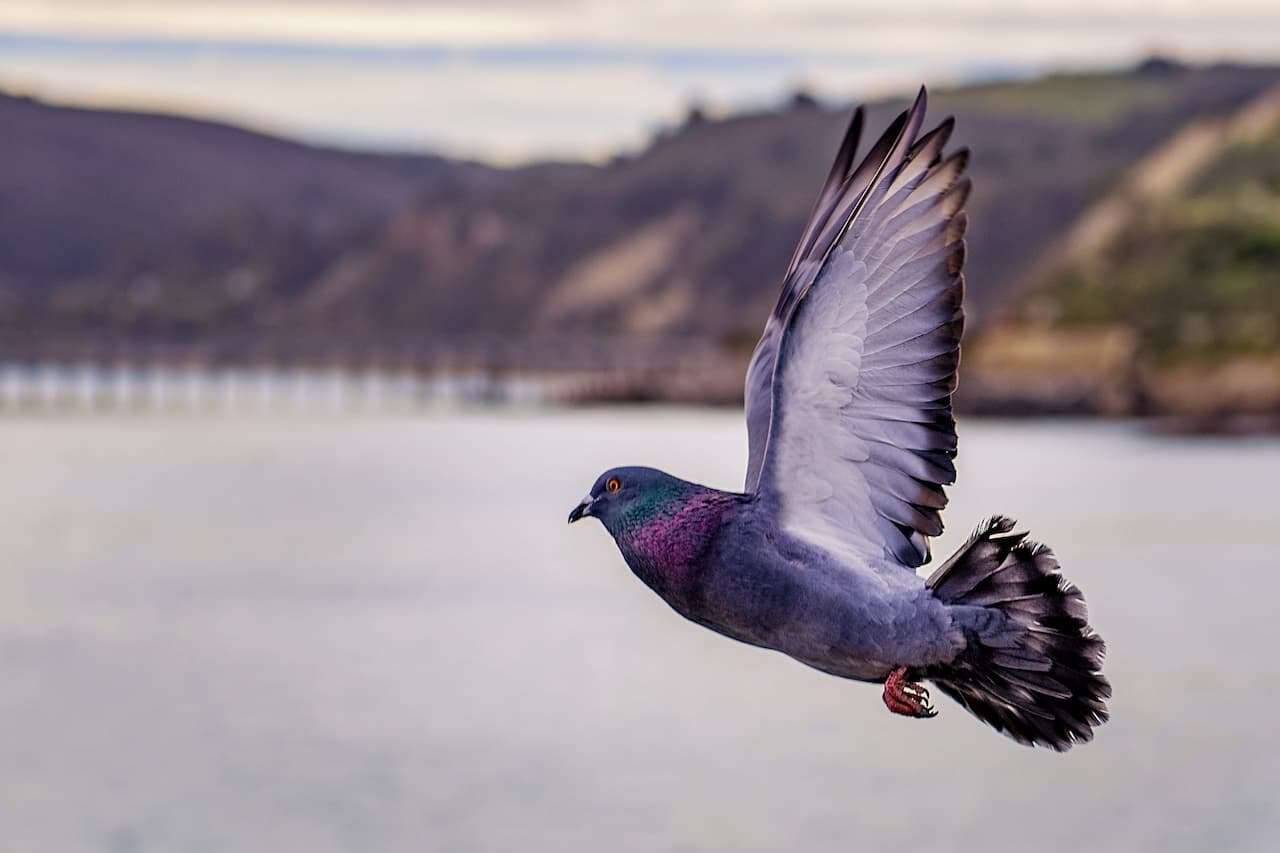Chestnut-breasted Munias / Mannikins or Finches
Finch Information … Index of Finch Species … Photos of the Different Finch Species for Identification … Common Health Problems of Finches … Finch / Canary Diet / Nutrition
Finch Data: Range, Length, Clutch-size and Incubation Periods for each Finch Species
The Chestnut-breasted Munias (Lonchura castaneothorax), also known as the Chestnut-breasted Mannikin, Chestnut-breasted Finch or Bully Bird (in Australia), is a small brown-backed munia with a black face and greyish crown and nape. It has a board ferruginous breast bar above a white belly.
Distribution / Range
The species is found in Australia, New Caledonia, Indonesia, and Papua New Guinea. This species is also introduced to French Polynesia and France.
Subspecies and location
The Chestnut-breasted Munias has a total of six subspecies and seven forms. The subspecies are as followed:
- L. c. castaneothorax (Nominate race) occurs in eastern Australia.
- L. c. assimilis occurs in northern Australia. Identification: Richer breast and cream ground color to belly and flanks.
- L. c. ramsayi occurs in southeastern Papua New Guinea. Identification: Distinctive black head with faint scalloping. Female is more noticeable than the male.
- L. c. boschmai occurs in Lake Wissel area in Irian Jaya. Identification: Brown scallops on the flanks and paler to straw on the upper tail-coverts.
- L. c. sharpii occurs in Hollandia, Irian Jaya and Papua New Guinea. Identification: Pale grey on the head, and dull upper tail-coverts.
- L. c. uropygialis occurs in Geelvink Bay in western Irian Jaya. Identification: Grey on the head not so pale, and note orange on the long upper tail-coverts.
L. castaneothora occurs in Tahiti. Apparently, it is descended from L. c. castaneothorax. They are distinguished today by having paler underparts and by the scalloping of the nape extended onto the mantle.
Habitat
In Australia, the Chestnut-breasted Munias is known as a bird of reed beds and rank grasses bordering rivers, in swamp, in grassy country, and mangroves. It is commonly found in cane fields and cereal crops. In dry seasons, it is seen in arid country but always near water. It is also found in grassy woodland. (Slater et al. 1986)
John Gould wrote of it (Cayley 1932):
“I had not the good fourtune to meet with this bird in a state of nature, but I have been informed that it frequents reed beds bordering the banks of rivers and lagoons on the eastern coast, and that it much resembles the Bearded Tit Panurus biarmicus, of Europe in the alertness with which it passes up and down the upright stems of reeds, from the lower part to the very top, a habit for which the lengthened and curved form of its claws seem well adapted.”
In New Guinea, the Chestnut-breasted Munias is a bird of drier areas and does not usually seen in jungle roads and clearings where other munias such as Grey-headed Mannikin are found.
In French Polynesia, it is well established as an introduced species, and its habits have developed somewhaat differently, indicating the adaptability of the species. It is widespread on the bracken-covered hill slopes, in pastures and gardens (it is not a garden bird in Australia), on cultivated land and wasteland, in forest ecotones and coconut plantations (Lever 1989)
Habits and food
In Australia, during the breeding season Chestnut-breasted Muniais mostly seen in pairs, but in late autumn and winter months it congregates in large flocks, at times eating seeds of cereal crops.
Chestnut-breasted Munia is a highly sociable species, flocking in large number outside the breeding season. Breeding birds will join groups or flocks when foraging.
It has a distinct liking for Barley seed and thus the local people give it a name, Barley Bird. (Cayley 1932) The species is also fond of paspalum grass Paspalum longifolium, bullrush millet Pennisetum typhoides and Sorghum species. It is also been recorded that it feeds on feral millet Pannicum maximum and wild sugar cane Saccharum robustum in Papua New Guinea. (Bapista 1990)
Copyright: Wikipedia. Parts of the above article is licensed under the GNU Free Documentation License. It uses material from Wikipedia.org … Additional information and photos by Avianweb.
Care and Feeding:
For further information, please refer to the finch websites listed under the heading or, for more general information, the below web resources are helpful:
-
- Sources for Purchasing or Adopting your Companion or Aviary Birds
-
- Bird Breeders
-
- Optimal nutrition to keep your bird healthy
-
- Housing your bird / Fun and Safe Toys
- Caring for your companion bird
Please Note: The articles or images on this page are the sole property of the authors or photographers. Please contact them directly with respect to any copyright or licensing questions. Thank you.






